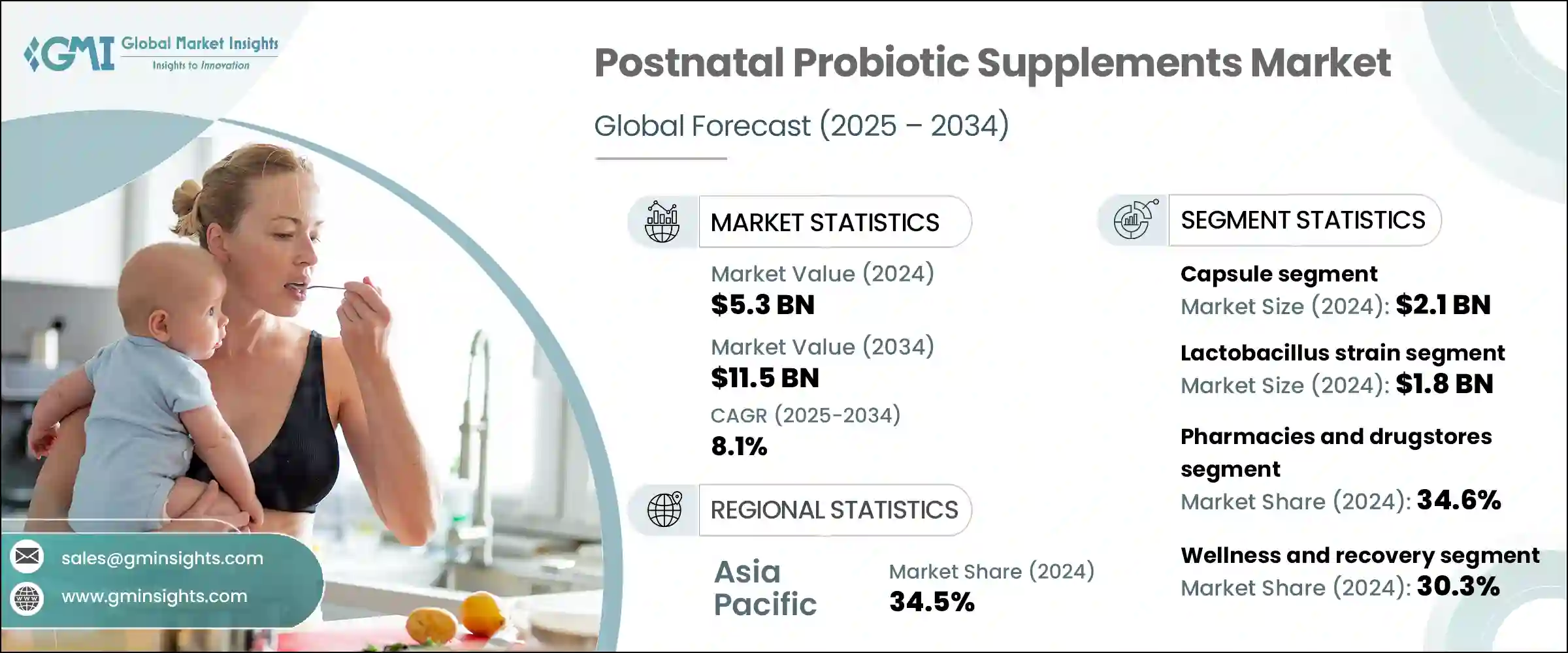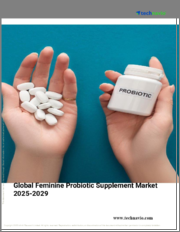
|
시장보고서
상품코드
1773401
산후 프로바이오틱스 보충제 시장 기회, 성장 촉진요인, 산업 동향 분석, 예측(2025-2034년)Postnatal Probiotic Supplements Market Opportunity, Growth Drivers, Industry Trend Analysis, and Forecast 2025 - 2034 |
||||||
세계의 산후 프로바이오틱스 보충제 시장은 2024년에는 53억 달러로 평가되며, CAGR 8.1%로 성장하며, 2034년에는 115억 달러에 달할 것으로 추정되고 있습니다.
이 보충제는 주로 유산균과 비피도박테리움의 유익한 균주가 함유되어 있으며, 산후 건강에 도움을 줍니다. 장내 균형을 회복하고, 면역 반응을 강화하며, 유선염과 같은 감염성 질환을 예방하고, 정서적 및 소화기 건강 유지에 도움을 줄 수 있습니다.

출산 후 자연스럽고 기능적인 회복 옵션에 대한 소비자의 관심 증가가 성장을 가속하는 주요 요인으로 작용하고 있습니다. 온라인 판매와 소매 유통 증가에 힘입어 임산부 케어에 대한 인식이 높아진 것도 수요를 확대하는 요인입니다. 또한 출산율이 높고 산모 건강 프로그램에 대한 접근성이 개선되고 있는 신흥 경제국은 강력한 성장 기회를 제공합니다. 개별화된 제형과 임상적으로 검증된 다중 시스템 솔루션에 대한 요구가 제품 환경을 더욱 형성하고 있습니다.
| 시장 범위 | |
|---|---|
| 시작연도 | 2024 |
| 예측연도 | 2025-2034 |
| 시작 금액 | 53억 달러 |
| 예측 금액 | 115억 달러 |
| CAGR | 8.1% |
더 많은 헬스케어 전문가들이 이 제품들을 지지하고, 주요 브랜드들이 포트폴리오 확장에 계속 투자함에 따라 시장은 혁신을 가속화하고 더 광범위한 보급이 예상됩니다. 균주별 효능이 임상적으로 입증되면서 신뢰와 수요가 증가함에 따라 각 업체들은 호르몬 균형, 소화기 지원, 면역 기능 등 산후 필요에 맞는 맞춤형 제제를 출시하고 있습니다.
생명공학 기업과 학술기관과의 연구 협력 증가는 과학적 근거에 기반한 제품 개발에 박차를 가하고 있습니다. 동시에, 특히 디지털 플랫폼을 통한 소매 유통이 확대되면서 이러한 보충제는 전 세계 산모들에게 더욱 친숙하게 다가갈 수 있게 되었습니다. 인식 개선 캠페인과 교육이 강화됨에 따라 산후 프로바이오틱스 보충제 채택이 크게 증가하여 현대 임산부 건강 습관의 핵심 요소로 자리 잡을 것으로 예측됩니다.
캡슐은 39.3%의 점유율을 차지하며 2024년 21억 달러를 창출했습니다. 캡슐의 장점은 사용 편의성, 장기 보관 안정성, 정확한 복용량, 다계통 제제와의 호환성과 관련이 있습니다. 캡슐은 식사와 관계없이 복용할 수 있고, 신뢰성이 높아 산후 소비자에게 특히 인기가 있습니다. 또한 임상 현장과 약국에서도 캡슐을 선호하고 있으며, 이는 캡슐의 신뢰성과 보급에 박차를 가하고 있습니다. 시장을 선도하는 많은 제제에는 출산 후 산모의 장과 면역 건강에 도움이 되는 주요 균주가 포함되어 있습니다.
유산균 균주 부문은 2024년 34.3%의 점유율을 차지하며 18억 달러에 달했습니다. 특히 L. acidophilus, L. salivarius, L. rhamnosus와 같이 잘 연구된 균주들은 내산성, 강력한 장내 집락 형성 능력, 산후 건강에 대한 입증된 효과로 인해 두드러지고 있습니다. 이 균은 염증을 억제하고 소화를 개선하며 산후에 흔히 발생하는 문제를 최소화하는 데 중요한 역할을 하며, 산모를 대상으로 하는 대부분의 프리미엄 제품에서 선호되는 성분입니다.
아시아태평양 산후 프로바이오틱스 보충제 시장은 2024년 34.5%의 점유율을 차지했습니다. 이 지역 국가들은 산후 회복에 대한 높은 인식과 기능성 영양 솔루션의 사용 증가로 인해 계속해서 우위를 점하고 있습니다. 산후 치유를 중심으로 한 문화적 관습도 소화 및 면역을 지원하는 프로바이오틱스 제품 채택에 유리한 조건을 조성하고 있습니다. 이러한 성장은 약국, 온라인 플랫폼, 웰빙 스토어를 통한 보충제에 대한 접근성이 확대되면서 더욱 가속화되고 있습니다.
Reckitt Benckiser Group plc, Danone S.A., Abbott Laboratories, Nestle S.A., BioGaia AB 등의 유명 기업은 요구에 맞춘 제품 발매 및 소비자 관여의 확대를 통해 이 지역에서 유통과 혁신 촉진에 기여하고 있습니다. 유통 및 혁신 촉진에 기여하고 있습니다. 산후 프로바이오틱스 분야의 신흥 국가 브랜드들은 시장 입지를 강화하기 위해 개별 제품 개발, 균주별 연구, 헬스케어 전문가와의 제휴에 집중하고 있습니다. 경쟁력을 유지하기 위해 각 업체들은 연구개발 투자를 늘리고, 면역력, 장 건강 등 산후에 나타나는 문제를 타겟으로 임상적으로 입증된 다중 균주 배합의 제품을 개발하고 있습니다. 또한 많은 기업이 E-Commerce 및 소비자 직접 판매를 확대하며 소비자 접점을 넓히고 있습니다. 육아 플랫폼, 소셜미디어, 웰니스 인플루언서를 통한 전략적 마케팅은 새로운 사용자들을 교육하고 끌어들이는 데 도움이 되고 있습니다.
목차
제1장 조사 방법과 범위
제2장 개요
제3장 업계 인사이트
- 에코시스템 분석
- 공급업체의 상황
- 이익률
- 각 단계에서의 부가가치
- 밸류체인에 영향을 미치는 요인
- 파괴적 변화
- 업계에 대한 영향요인
- 촉진요인
- 업계의 잠재적 리스크 & 과제
- 시장 기회
- 성장 가능성 분석
- 규제 상황
- 북미
- 유럽
- 아시아태평양
- 라틴아메리카
- 중동 및 아프리카
- Porter의 산업 분석
- PESTEL 분석
- 가격 동향
- 지역별
- 제품별
- 향후 시장 동향
- 테크놀러지와 혁신의 상황
- 현재 기술 동향
- 신규 기술
- 특허 상황
- 무역통계(HS 코드)(주 : 무역통계는 주요 국가만 제공)
- 주요 수입국
- 주요 수출국
- 지속가능성과 환경 측면
- 지속가능 관행
- 폐기물 삭감 전략
- 생산에서의 에너지 효율
- 친환경 구상
제4장 경쟁 구도
- 서론
- 기업의 시장 점유율 분석
- 지역별
- 북미
- 유럽
- 아시아태평양
- 라틴아메리카 항공
- 중동 및 아프리카
- 지역별
- 기업 매트릭스 분석
- 주요 시장 기업의 경쟁 분석
- 경쟁 포지셔닝 매트릭스
- 주요 발전
- 합병과 인수
- 파트너십과 협업
- 신제품 발매
- 확장 계획
제5장 시장 추산·예측 : 제품 유형별, 2021-2034
- 주요 동향
- 캡슐
- 분말
- 구미
- 액체
- 기타(소프트젤, 사쉐)
제6장 시장 추산·예측 : 프로바이오틱스 균주별, 2021-2034
- 주요 동향
- 유산균속
- L. rhamnosus
- L. salivarius
- L. acidophilus
- 8.2 비피도박테리움속
- B. longum
- B. lactis
- 다균주 제제
- 새로운 주
제7장 시장 추산·예측 : 유통 채널별, 2021-2034
- 주요 동향
- 온라인 소매
- 약국과 드러그스토어
- 슈퍼마켓과 하이퍼마켓
- 전문 건강식품점
- 헬스케어 시설
제8장 시장 추산·예측 : 용도별, 2021-2034
- 주요 동향
- 소화기계 건강 지원
- 면역 시스템 강화
- 기분과 정신건강 지원
- 유선염 예방과 치료
- 전체적인 건강과 회복
제9장 시장 추산·예측 : 지역별, 2021-2034
- 주요 동향
- 북미
- 미국
- 캐나다
- 유럽
- 독일
- 영국
- 프랑스
- 스페인
- 이탈리아
- 네덜란드
- 기타 유럽 지역
- 아시아태평양
- 중국
- 인도
- 일본
- 호주
- 한국
- 기타 아시아태평양
- 라틴아메리카
- 브라질
- 멕시코
- 아르헨티나
- 기타 라틴아메리카 지역
- 중동 및 아프리카
- 사우디아라비아
- 남아프리카공화국
- 아랍에미리트
- 기타 중동 및 아프리카 지역
제10장 기업 개요
- Abbott Laboratories
- BioGaia AB
- Danone S.A.
- Nestle S.A.
- Bayer AG
- Reckitt Benckiser Group plc
- DuPont Nutrition &Biosciences
The Global Postnatal Probiotic Supplements Market was valued at USD 5.3 billion in 2024 and is estimated to grow at a CAGR of 8.1% to reach USD 11.5 billion by 2034. These supplements are formulated with beneficial strains of bacteria, primarily from the Lactobacillus and Bifidobacterium families, to support postpartum wellness. They aid in restoring gut balance, enhancing immune response, preventing infections such as mastitis, and contributing to emotional and digestive well-being.

Rising consumer interest in natural and functional recovery options after childbirth is a key factor fueling growth. Growing awareness around maternal care, supported by increasing online and retail distribution, is also amplifying demand. In addition, emerging economies with high birth rates and improving access to maternal health programs present strong expansion opportunities. The need for personalized formulations and clinically validated, multi-strain solutions is further shaping the product landscape.
| Market Scope | |
|---|---|
| Start Year | 2024 |
| Forecast Year | 2025-2034 |
| Start Value | $5.3 Billion |
| Forecast Value | $11.5 Billion |
| CAGR | 8.1% |
The market is set for accelerated innovation and broader adoption as more healthcare professionals endorse these products, and major brands continue to invest in expanding their portfolios. Clinical validation of strain-specific benefits is driving greater trust and demand, prompting companies to introduce targeted formulations tailored to postpartum needs such as hormonal balance, digestive support, and immune function.
Increasing research collaborations between biotech firms and academic institutions are also fueling product development rooted in science-backed outcomes. Simultaneously, expanding retail availability, especially through digital platforms, makes these supplements more accessible to new mothers globally. As awareness campaigns and educational outreach strengthen, the adoption of postnatal probiotic supplements is expected to rise significantly, turning them into a core component of modern maternal health routines.
The capsules segment held a 39.3% share and generated USD 2.1 billion in 2024. Their dominance is tied to ease of use, long shelf stability, precise dosing, and compatibility with multi-strain formulations. Capsules are particularly popular with postpartum consumers due to their ability to be taken with or without meals and their perceived reliability. Clinical settings and pharmacies also favor capsule delivery, which adds to their strong credibility and uptake. Many market-leading formulations include key bacterial strains that address gut and immune health in mothers following childbirth.
The Lactobacillus strain segment accounted for a 34.3% share in 2024, amounting to USD 1.8 billion. These strains-especially well-researched types like L. acidophilus, L. salivarius, and L. rhamnosus-are prominent due to their acid resistance, strong gut colonization ability, and proven benefits for postnatal health. They play a crucial role in reducing inflammation, improving digestion, and minimizing common postpartum issues, making them a preferred choice in most premium formulations targeting new mothers.
Asia Pacific Postnatal Probiotic Supplements Market held a 34.5% share in 2024. Countries across this region continue to dominate due to high awareness of postnatal recovery and the increasing use of functional nutrition solutions. Cultural practices centered on postpartum healing also create favorable conditions for the adoption of probiotic products that support digestion and immunity. This growth is further supported by growing access to supplements through pharmacies, online platforms, and wellness stores.
Prominent companies like Reckitt Benckiser Group plc, Danone S.A., Abbott Laboratories, Nestle S.A., and BioGaia AB have helped in driving distribution and innovation within the region through tailored product launches and growing consumer engagement. Leading brands in the postnatal probiotic sector are focused on personalized product development, strain-specific research, and partnerships with healthcare professionals to strengthen their market position. To stay competitive, companies are increasing R&D investments to develop clinically proven, multi-strain formulas targeting postpartum concerns like immunity and gut health. Many are also expanding their e-commerce footprint and direct-to-consumer sales to boost reach. Strategic marketing through parenting platforms, social media, and wellness influencers helps educate and attract new users.
Table of Contents
Chapter 1 Methodology & Scope
- 1.1 Market scope and definition
- 1.2 Research design
- 1.2.1 Research approach
- 1.2.2 Data collection methods
- 1.3 Data mining sources
- 1.3.1 Global
- 1.3.2 Regional/Country
- 1.4 Base estimates and calculations
- 1.4.1 Base year calculation
- 1.4.2 Key trends for market estimation
- 1.5 Primary research and validation
- 1.5.1 Primary sources
- 1.6 Forecast model
- 1.7 Research assumptions and limitations
Chapter 2 Executive Summary
- 2.1 Industry 3600 synopsis
- 2.2 Key market trends
- 2.2.1 Regional
- 2.2.2 Product type
- 2.2.3 Probiotic strain
- 2.2.4 Distribution channel
- 2.2.5 Application
- 2.3 TAM Analysis, 2025-2034
- 2.4 CXO perspectives: Strategic imperatives
- 2.4.1 Executive decision points
- 2.4.2 Critical success factors
- 2.5 Future Outlook and strategic recommendations
Chapter 3 Industry Insights
- 3.1 Industry ecosystem analysis
- 3.1.1 Supplier Landscape
- 3.1.2 Profit Margin
- 3.1.3 Value addition at each stage
- 3.1.4 Factor affecting the value chain
- 3.1.5 Disruptions
- 3.2 Industry impact forces
- 3.2.1 Growth drivers
- 3.2.2 Industry pitfalls and challenges
- 3.2.3 Market opportunities
- 3.3 Growth potential analysis
- 3.4 Regulatory landscape
- 3.4.1 North America
- 3.4.2 Europe
- 3.4.3 Asia Pacific
- 3.4.4 Latin America
- 3.4.5 Middle East & Africa
- 3.5 Porter's analysis
- 3.6 PESTEL analysis
- 3.6.1 Technology and innovation landscape
- 3.6.2 Current technological trends
- 3.6.3 Emerging technologies
- 3.7 Price trends
- 3.7.1 By region
- 3.7.2 By product
- 3.8 Future market trends
- 3.9 Technology and innovation landscape
- 3.9.1 Current technological trends
- 3.9.2 Emerging technologies
- 3.10 Patent Landscape
- 3.11 Trade statistics (HS code) (Note: the trade statistics will be provided for key countries only)
- 3.11.1 Major importing countries
- 3.11.2 Major exporting countries
- 3.12 Sustainability and environmental aspects
- 3.12.1 Sustainable practices
- 3.12.2 Waste reduction strategies
- 3.12.3 Energy efficiency in production
- 3.12.4 Eco-friendly Initiatives
Chapter 4 Competitive Landscape, 2024
- 4.1 Introduction
- 4.2 Company market share analysis
- 4.2.1 By region
- 4.2.1.1 North America
- 4.2.1.2 Europe
- 4.2.1.3 Asia Pacific
- 4.2.1.4 LATAM
- 4.2.1.5 MEA
- 4.2.1 By region
- 4.3 Company matrix analysis
- 4.4 Competitive analysis of major market players
- 4.5 Competitive positioning matrix
- 4.6 Key developments
- 4.6.1 Mergers & acquisitions
- 4.6.2 Partnerships & collaborations
- 4.6.3 New product launches
- 4.6.4 Expansion plans
Chapter 5 Market Estimates and Forecast, By Product Type, 2021 - 2034 (USD Million) (Kilo Tons)
- 5.1 Key trends
- 5.2 Capsules
- 5.3 Powders
- 5.4 Gummies
- 5.5 Liquids
- 5.6 Others (soft gels, sachets)
Chapter 6 Market Estimates and Forecast, By Probiotic Strain, 2021 - 2034 (USD Million) (Kilo Tons)
- 6.1 Key trends
- 6.2 Lactobacillus species
- 6.2.1 L. rhamnosus
- 6.2.2 L. salivarius
- 6.2.3 L. acidophilus
- 6.3 8.2 Bifidobacterium species
- 6.3.1 B. longum
- 6.3.2 B. lactis
- 6.4 Multi-strain formulations
- 6.5 Emerging strains
Chapter 7 Market Estimates and Forecast, By Distribution Channel, 2021 - 2034 (USD Million) (Kilo Tons)
- 7.1 Key trends
- 7.2 Online retail
- 7.3 Pharmacies and drug stores
- 7.4 Supermarkets and hypermarkets
- 7.5 Specialty health stores
- 7.6 Healthcare facilities
Chapter 8 Market Estimates and Forecast, By Application, 2021 - 2034 (USD Million) (Kilo Tons)
- 8.1 Key trends
- 8.2 Digestive health support
- 8.3 Immune system enhancement
- 8.4 Mood and mental health support
- 8.5 Mastitis prevention and treatment
- 8.6 Overall wellness and recovery
Chapter 9 Market Estimates and Forecast, By Region, 2021 - 2034 (USD Million) (Kilo Tons)
- 9.1 Key trends
- 9.2 North America
- 9.2.1 U.S.
- 9.2.2 Canada
- 9.3 Europe
- 9.3.1 Germany
- 9.3.2 UK
- 9.3.3 France
- 9.3.4 Spain
- 9.3.5 Italy
- 9.3.6 Netherlands
- 9.3.7 Rest of Europe
- 9.4 Asia Pacific
- 9.4.1 China
- 9.4.2 India
- 9.4.3 Japan
- 9.4.4 Australia
- 9.4.5 South Korea
- 9.4.6 Rest of Asia Pacific
- 9.5 Latin America
- 9.5.1 Brazil
- 9.5.2 Mexico
- 9.5.3 Argentina
- 9.5.4 Rest of Latin America
- 9.6 Middle East and Africa
- 9.6.1 Saudi Arabia
- 9.6.2 South Africa
- 9.6.3 UAE
- 9.6.4 Rest of Middle East and Africa
Chapter 10 Company Profiles
- 10.1 Abbott Laboratories
- 10.2 BioGaia AB
- 10.3 Danone S.A.
- 10.4 Nestle S.A.
- 10.5 Bayer AG
- 10.6 Reckitt Benckiser Group plc
- 10.7 DuPont Nutrition & Biosciences


















